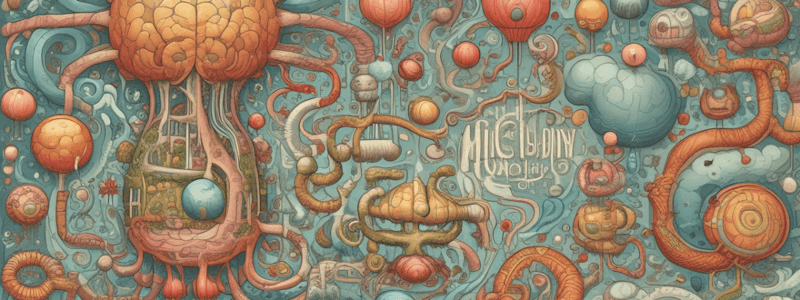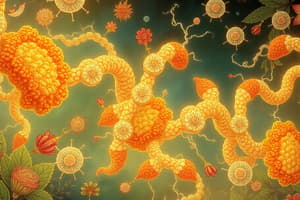Podcast
Questions and Answers
What is the main function of kinesin, dynein, and myosin in cells?
What is the main function of kinesin, dynein, and myosin in cells?
- To synthesize chemicals
- To regulate cell growth
- To move along microtubules and microfilaments (correct)
- To transport membranes
What is the role of the cytoskeleton in cell motility?
What is the role of the cytoskeleton in cell motility?
- It pushes the front end and pulls the back of the cell forward (correct)
- It prevents cell movement
- It only pushes the front end of the cell
- It only pulls the back of the cell forward
What type of cell movement is involved in embryonic development?
What type of cell movement is involved in embryonic development?
- Cell motility (correct)
- Cell apoptosis
- Cell mitosis
- Cell migration
What is the name of the protist that uses cilia to swim?
What is the name of the protist that uses cilia to swim?
What is the term for the movement of entire cells?
What is the term for the movement of entire cells?
What type of work is involved in the synthesis of chemicals?
What type of work is involved in the synthesis of chemicals?
What is the primary research focus of Ashley Garrill's research group?
What is the primary research focus of Ashley Garrill's research group?
What is the main purpose of using a Lab-on-a-Chip device in Ashley Garrill's research?
What is the main purpose of using a Lab-on-a-Chip device in Ashley Garrill's research?
What is the equivalent pressure exerted by oomycete hyphae on plant tissue?
What is the equivalent pressure exerted by oomycete hyphae on plant tissue?
What is the recommended reading for the next two weeks?
What is the recommended reading for the next two weeks?
What is the primary focus of the lectures in BIOL/BCHM 111?
What is the primary focus of the lectures in BIOL/BCHM 111?
Where did Ashley Garrill complete her BSc degree?
Where did Ashley Garrill complete her BSc degree?
What is the purpose of the question box in the lectures?
What is the purpose of the question box in the lectures?
What is Ashley Garrill's approach to student questions in the lectures?
What is Ashley Garrill's approach to student questions in the lectures?
What type of work is involved in the movement of molecules or ions across membranes?
What type of work is involved in the movement of molecules or ions across membranes?
What percentage of energy used by the brain is used to move Na+ and K+ across cell membranes?
What percentage of energy used by the brain is used to move Na+ and K+ across cell membranes?
What is the purpose of the Ca2+ pump in muscle cells?
What is the purpose of the Ca2+ pump in muscle cells?
What is the process by which macromolecules are formed from monomer subunits?
What is the process by which macromolecules are formed from monomer subunits?
What is the main reason why cells can do work?
What is the main reason why cells can do work?
What is an example of membrane transport in nerve cells?
What is an example of membrane transport in nerve cells?
What is the purpose of membrane transport in cells?
What is the purpose of membrane transport in cells?
What enables cells to exhibit characteristics of life, such as growth and development?
What enables cells to exhibit characteristics of life, such as growth and development?
What is the primary function of enzymes in a cell?
What is the primary function of enzymes in a cell?
What is the first step in the glycolysis pathway?
What is the first step in the glycolysis pathway?
What is the result of a metabolic pathway in a cell that is in a state of metabolic disequilibrium?
What is the result of a metabolic pathway in a cell that is in a state of metabolic disequilibrium?
What is the primary function of catabolic pathways?
What is the primary function of catabolic pathways?
What is the role of energy carriers in metabolic pathways?
What is the role of energy carriers in metabolic pathways?
How are metabolic pathways regulated in a cell?
How are metabolic pathways regulated in a cell?
What happens to the energy derived from catabolic pathways?
What happens to the energy derived from catabolic pathways?
What is the term used to describe the regulation of metabolic pathways based on the energy needs of the cell?
What is the term used to describe the regulation of metabolic pathways based on the energy needs of the cell?
What happens to the sugar in the egg when energy levels are low?
What happens to the sugar in the egg when energy levels are low?
What is the purpose of metabolic regulation?
What is the purpose of metabolic regulation?
What type of pathway is involved in breaking down glucose?
What type of pathway is involved in breaking down glucose?
What happens to the glucose in the egg when energy levels are high?
What happens to the glucose in the egg when energy levels are high?
What is the role of enzymes in metabolic regulation?
What is the role of enzymes in metabolic regulation?
What is the term for the storage carbohydrate?
What is the term for the storage carbohydrate?
What is the purpose of the catabolic pathway?
What is the purpose of the catabolic pathway?
What is the result of cells being able to control their metabolism?
What is the result of cells being able to control their metabolism?
Flashcards are hidden until you start studying
Study Notes
Introduction to BIOL/BCHM 111
- Lecturer: Ashley Garrill, with a background in Genetics and Plant Biology (BSc) and Genetics and Microbiology (PhD)
- Research focus: Cell biology and biophysics of pathogenic microorganisms, including fungi and oomycetes
Course Overview
- Lectures cover metabolism, energetics, and membrane transport
- Reading material: Biology 2e (WEB) and Biology: A Global Approach (11th Edition)
- Encouragement to ask questions and participate in lectures
Types of Work
- Movement: powered by motor proteins (kinesin, dynein, myosin) and involves the cytoskeleton
- Membrane Transport: important for maintaining osmotic balance with the surrounding solution
- Chemical Synthesis: enables the formation of macromolecules from monomer subunits
Cell Movement
- Cells can move using their cytoskeleton to push and pull the front and back of the cell
- Actin enables cell motility
- Other cells use cilia or flagella to swim
- Multicellular animals move due to muscle contraction
Membrane Transport
- Important for maintaining osmotic balance with the surrounding solution
- Na+/K+ pumps use 50% of the brain's energy to maintain ion balance
- Ca2+ pumps are important in muscle cells to regulate Ca2+ levels
Chemical Synthesis
- Enables the formation of macromolecules from monomer subunits
- Polysaccharides are formed from sugars, proteins from amino acids, and nucleic acids from nucleotides
Characteristics of Life
- Movement, membrane transport, and chemical synthesis enable growth, development, regulation, and response to the environment
Work and Energy
- Cells can do work because they can transform molecules and energy
- Energy is derived from catabolic pathways and can be used to drive anabolic pathways
Metabolism
- Metabolic pathways can be catabolic (breakdown complex molecules) or anabolic (build complex molecules)
- Energy carriers: ATP, NADH, NADPH
- Metabolic pathways are regulated depending on the energy needs of the cell/organism
Metabolic Regulation
- Enzymes are regulated allosterically, covalently, or genetically to control metabolic pathways
- Energy levels affect the regulation of metabolic pathways
- Examples: glucose breakdown in the absence/presence of breakfast
Studying That Suits You
Use AI to generate personalized quizzes and flashcards to suit your learning preferences.




